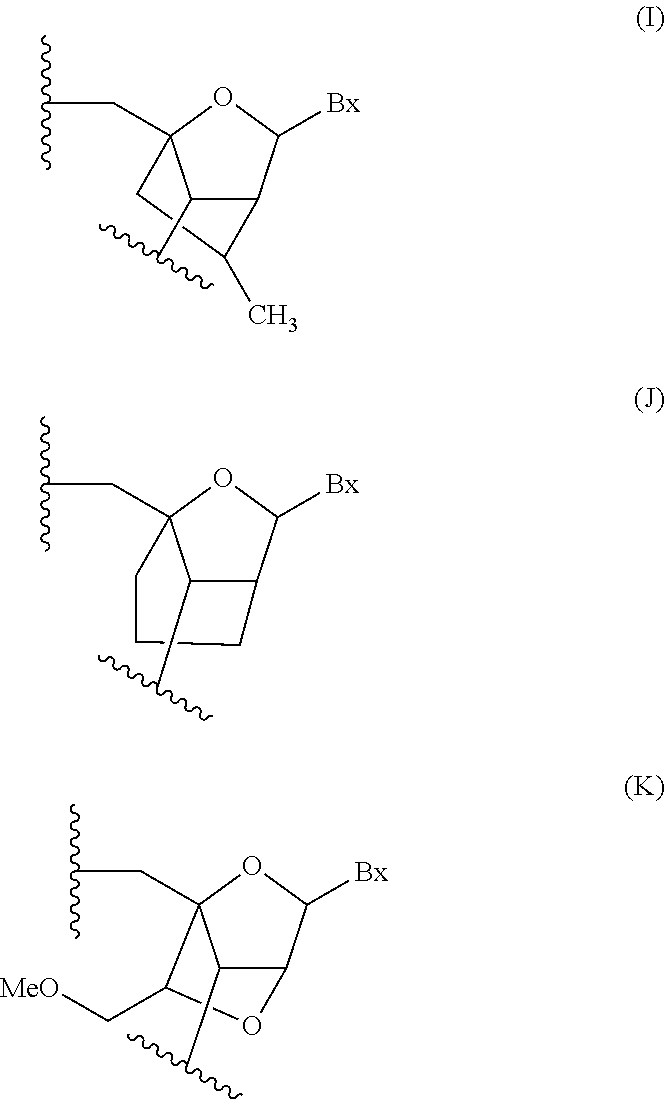Selective antisense compounds and uses thereof
a selective and antisense technology, applied in the field of selective antisense compounds, can solve the problems of cleavage of the mrna and interfere with polyadenylation, and achieve the effect of reducing one or more symptom of the diseas
- Summary
- Abstract
- Description
- Claims
- Application Information
AI Technical Summary
Benefits of technology
Problems solved by technology
Method used
Image
Examples
example 1
Single Nucleotide Polymorphisms (SNPs) in the Huntingtin (HTT) Gene Sequence
[0506]SNP positions (identified by Hayden et al, WO / 2009 / 135322) associated with the HTT gene were mapped to the HTT genomic sequence, designated herein as SEQ ID NO: 1 (NT—006081.18 truncated from nucleotides 1566000 to 1768000). Table 5 provides SNP positions associated with the HTT gene. Table 5 provides a reference SNP ID number from the Entrez SNP database at the National Center for Biotechnology Information (NCBI, http: / / www.ncbi.nlm.nih.gov / sites / entrez?db=snp), incorporated herein by reference. Table 5 furnishes further details on each SNP. The ‘Reference SNP ID number’ or ‘RS number’ is the number designated to each SNP from the Entrez SNP database at NCBI, incorporated herein by reference. ‘SNP position’ refers to the nucleotide position of the SNP on SEQ ID NO: 1. ‘Polymorphism’ indicates the nucleotide variants at that SNP position. ‘Major allele’ indicates the nucleotide associated with the majo...
example 2
Modified Oligonucleotides Targeting Huntingtin (HTT) SNPs and Bone Morphogenetic Protein Receptor 1A (BMPR1A)
[0507]A series of modified oligonucleotides were designed to target SNP positions associated with the HTT gene. These modified oligonucleotides were evaluated for their ability to selectively inhibit mutant (mut) HTT while leaving the expression of the wild-type (wt) HTT and BMPR1A intact. In the tables, ‘k’ subscript indicates an (S)-cEt modification; ‘e’ subscript indicates MOE modification; ‘m’ before the cytosine residue indicates a 5-methyl cytosine; ‘x’ before the thymine residue indicates a 2-thiothymine; the number along with ‘d’ indicates the number of deoxyribose nucleosides; ‘o’ subscript after the sugar modification subscripts indicates a phosphodiester internucleoside linkage; ‘s’ subscript after the nucleoside indicates a phosphorothioate internucleoside linkage.
[0508]As described above in Example 1, certain SNPs may have two or more allelic variants. For exampl...
example 3
Modified Oligonucleotides Targeting HTT SNP Rs7685686 and BMPR1A
[0512]A series of modified oligonucleotides were designed to target SNP positions associated with the HTT gene and BMPR1A. These modified oligonucleotides were evaluated for their ability to selectively inhibit mutant (mut) HTT while leaving the expression of the wild-type (wt) HTT and BMPR1A intact. In the tables, ‘k’ subscript indicates an (S)-cEt modification; ‘e’ subscript indicates MOE modification; ‘m’ before the cytosine residue indicates a 5-methyl cytosine; ‘x’ before the thymine residue indicates a 2-thiothymine; the number along with ‘d’ indicates the number of deoxyribose nucleosides; ‘o’ subscript after the sugar modification subscripts indicates a phosphodiester internucleoside linkage; ‘s’ subscript after the nucleoside indicates a phosphorothioate internucleoside linkage.
[0513]The modified oligonucleotides presented in Table 8 were tested in vitro. Selective inhibition of the modified oligonucleotides ta...
PUM
| Property | Measurement | Unit |
|---|---|---|
| Length | aaaaa | aaaaa |
| Length | aaaaa | aaaaa |
| Length | aaaaa | aaaaa |
Abstract
Description
Claims
Application Information
 Login to View More
Login to View More - R&D
- Intellectual Property
- Life Sciences
- Materials
- Tech Scout
- Unparalleled Data Quality
- Higher Quality Content
- 60% Fewer Hallucinations
Browse by: Latest US Patents, China's latest patents, Technical Efficacy Thesaurus, Application Domain, Technology Topic, Popular Technical Reports.
© 2025 PatSnap. All rights reserved.Legal|Privacy policy|Modern Slavery Act Transparency Statement|Sitemap|About US| Contact US: help@patsnap.com



